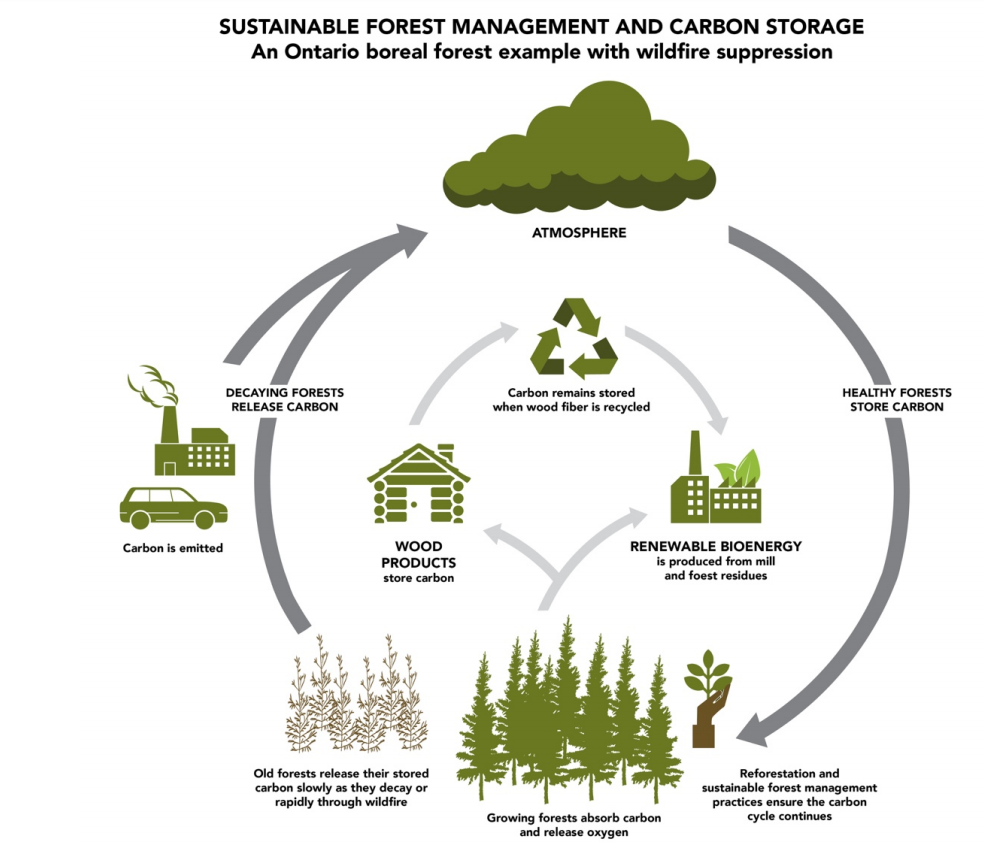What Is Carbon Sequestration?
Carbon sequestration refers to the decarbonisation technique that captures and stores carbon dioxide (CO₂) from the environment to mitigate climate change. This can occur naturally through forests, soils, and oceans or through technological solutions like carbon capture and storage (CCS) and Direct Air Capture (DAC). During photosynthesis, trees absorb CO₂ from the air and store it in their trunks, roots, and soil (Stirbet et al., 2020) This process not only reduces the concentration of CO₂ in the atmosphere but also helps mitigate climate change while supporting biodiversity. There are two main types of carbon sequestration:
- Biological Sequestration: This natural process involves plants, trees, soils, microbes, and oceans absorbing and storing carbon from the atmosphere. This process occurs primarily through photosynthesis, where plants absorb carbon dioxide (CO₂) and convert it into organic matter, storing carbon in their biomass (trunks, branches, leaves, and roots) and in the soil (Gayathri et al., 2021).
- Geological Sequestration: This human-engineered method involves capturing CO₂ and storing it in underground rock formations. This method is a form of carbon capture and storage (CCS) that prevents CO₂ from entering the atmosphere and contributing to climate change (Su et al., 2023).
Forests are among the most effective natural carbon sinks, making their conservation crucial for maintaining the global carbon balance.
The Critical Role of Carbon Sequestration in Forest Conservation
Forests play an indispensable role in maintaining the planet’s climate stability. They serve as crucial carbon sinks, capturing and storing carbon dioxide (CO₂) from the atmosphere, thus mitigating the harmful impacts of climate change (Nunes et al., 2020). In recent years, the importance of carbon sequestration in forests has come into sharper focus as scientists and environmentalists work to address the rising levels of greenhouse gases, particularly CO₂, in the atmosphere. Protecting and conserving forests is essential not only for their intrinsic ecological value but also for their role in combating global warming and supporting sustainable climate action (Nunes et al., 2020). This article explores the significance of carbon sequestration in forests, the impact of deforestation on climate change, and why forest conservation is vital for achieving a climate-resilient future.

Source: AZOCLEANTECH
Forests as Carbon Sinks
Forests function as natural carbon sinks, absorbing large quantities of carbon dioxide from the atmosphere during photosynthesis. Trees and other vegetation take in CO₂, convert it into oxygen, and store carbon in their biomass, such as roots, stems, leaves, and soil. A healthy forest can sequester vast amounts of carbon, making it one of the most effective methods of reducing atmospheric CO₂. According to the World Resources Institute (2021), forests absorb approximately 7.6 billion tonnes of carbon annually. This carbon sequestration helps offset the emissions produced by human activities, such as the burning of fossil fuels, industrial processes, and transportation.
Forests sequester carbon at varying rates owing to factors like forest type, tree age, climate, and management practices. Young, fast-growing forests absorb carbon quickly, while older, mature forests store it for longer periods (Wernick and Kauppi, 2022). Tropical rainforests, temperate forests, and boreal forests each play distinct roles in carbon storage. Regardless of type, all forests are vital in maintaining the global carbon balance and mitigating climate change.
The Importance of Forest Conservation
As carbon sinks, forests contribute significantly to climate stability, which underscores the importance of forest conservation. However, forests are under threat from various human activities, most notably deforestation, illegal logging, and land conversion for agriculture. Every year, millions of hectares of forests are lost owing to these activities, resulting in the release of stored carbon back into the atmosphere. Deforestation is a major driver of global greenhouse gas emissions, contributing approximately 10-15% of global CO₂ emissions (Panchasara et al., 2021).
Forest conservation is essential to preserving the carbon sequestration capabilities of forests. When forests are destroyed or degraded, not only is their capacity to absorb carbon diminished, but the carbon stored in the biomass is also released into the atmosphere, exacerbating climate change. Therefore, protecting forests from deforestation and degradation is one of the most effective and immediate actions we can take to mitigate global warming and reduce our carbon footprint.
Climate Change and Carbon Sequestration
The Earth’s climate is significantly impacted by the increasing concentration of greenhouse gases in the atmosphere, primarily CO₂ (Filonchyk et al., 2024). These gases trap heat and contribute to the phenomenon of global warming. The effects of climate change are already being felt around the world, from rising sea levels and extreme weather events to disrupted ecosystems and loss of biodiversity. One of the key strategies for combating climate change is to reduce the levels of CO₂ in the atmosphere, and carbon sequestration in forests plays a vital role in this process.
In addition to absorbing carbon, forests help regulate the global water cycle, prevent soil erosion, and provide habitats for countless species. By maintaining healthy forests, we can combat climate change and safeguard essential ecosystem services that are vital for human well-being. In this regard, forest conservation is a crucial component of any global climate action plan.
Forest Carbon Storage and Deforestation
Carbon storage in forests is an ongoing process, with carbon being sequestered during the growth of trees and other vegetation. However, when forests are destroyed or degraded, this process is interrupted, and the carbon stored in the trees is released into the atmosphere. Deforestation, whether for agriculture, urbanisation, or logging, has devastating consequences for carbon storage and climate change.
The Amazon Rainforest, often referred to as the “lungs of the Earth,” is one of the largest carbon sinks on the planet. However, it is facing significant threats owing to deforestation driven by logging, agricultural expansion, and mining. The loss of this vital forest ecosystem has serious implications for global carbon emissions and climate stability. Protecting forests like the Amazon is essential to maintaining the Earth’s ability to sequester carbon and mitigate the effects of global warming.
In addition to large-scale deforestation, forest degradation is another critical issue. Forest degradation refers to the decline in the quality of a forest owing to human activities. This degradation reduces the forest’s ability to sequester carbon and disrupts the delicate balance of the ecosystem (Watson et al., 2018).
Reducing Carbon Footprint Through Forests
One of the most effective ways individuals, communities, and nations can reduce their carbon footprint is through forest conservation and restoration efforts. Planting trees, restoring degraded lands, and protecting existing forests are all strategies that contribute to enhancing carbon sequestration. In addition, reducing deforestation and promoting sustainable land-use practices can help maintain the global carbon sink function of forests.
Carbon offset programs, such as those that support tree planting and forest restoration, allow individuals and businesses to compensate for their carbon emissions by investing in forest conservation projects. These initiatives not only reduce atmospheric CO₂ levels but also provide economic benefits to local communities, create jobs, and support biodiversity conservation.
The Role of Forests in Global Warming
Forests play an essential role in mitigating global warming (Psistaki et al., 2024). The Earth’s rising temperatures are largely driven by the increased concentration of greenhouse gases, especially CO₂, in the atmosphere. Forests act as a natural counterbalance to these emissions, absorbing and storing carbon that would otherwise contribute to the greenhouse effect.
In addition to their role as carbon sinks, forests help regulate temperatures by providing shade and cooling the surrounding environment through a process known as evapotranspiration. This process involves the release of water vapour from trees into the atmosphere, which cools the air and helps regulate local climates. This cooling effect is significant in urban areas, where the heat island effect can exacerbate the impacts of global warming.
How Forests Help Combat Climate Change
Forests help combat climate change in several key ways. Firstly, they sequester carbon through the process of photosynthesis, removing CO₂ from the atmosphere and storing it in plant biomass and soils. Secondly, forests help regulate local and global climates by influencing temperature and precipitation patterns. Thirdly, healthy forests contribute to biodiversity conservation, which is essential for maintaining resilient ecosystems that can adapt to changing environmental conditions.
By absorbing and storing carbon, forests act as a buffer against the impacts of climate change, reducing the overall concentration of greenhouse gases in the atmosphere. In addition, forests play a critical role in the water cycle, preventing floods, droughts, and soil erosion. These ecosystem services are invaluable in maintaining the stability of the climate and providing resources for human populations.
Protecting Forests for Carbon Sequestration
To ensure that forests continue to function as effective carbon sinks, it is essential to implement strategies that protect and conserve them. This includes enforcing laws against illegal logging, promoting sustainable forest management practices, and supporting reforestation and afforestation efforts. In addition, addressing the drivers of deforestation, such as unsustainable agricultural practices and urban expansion, is critical to preserving the world’s forests.
Governments, international organisations, and local communities must collaborate to develop and implement policies that protect forests. This can include creating protected areas, offering incentives for sustainable land management, and engaging in forest restoration initiatives. Investing in forest conservation not only helps mitigate climate change but also supports local economies, improves livelihoods, and enhances biodiversity (Oldekop et al., 2020).
Sustainable Forest Management
Sustainable forest management (SFM) is an approach that seeks to balance ecological, social, and economic needs. It ensures that forests continue to provide essential services, such as carbon sequestration, while meeting the demands for timber and other forest products (Sheppak et al., 2020). Practices like selective logging, agroforestry, and replanting trees help maintain forest health (Fahad et al.,2022). Additionally, sustainable practices allow for the long-term viability of forest ecosystems, ensuring they can continue sequestering carbon. By promoting SFM, we can create a future where forests contribute to both climate stability and economic development.

Source: Ontario
The Benefits of Forest Conservation
Conserving forests provides more than just climate benefits. Healthy forests offer numerous other ecosystem services, such as improving air quality, regulating water cycles, and supporting biodiversity. They also provide food, medicine, and materials for millions of people around the world. Forests help mitigate natural disasters like floods and droughts, which are increasingly frequent owing to climate change. Furthermore, forests offer cultural, recreational, and aesthetic value, enriching human life. Therefore, conserving forests not only helps in the fight against climate change but also ensures a healthier, more resilient world for future generations.
Forest Conservation for Climate Stability
Forest conservation is an essential strategy in the global fight against climate change. By protecting forests, we maintain their ability to act as carbon sinks, absorbing and storing CO₂. This helps reduce the concentration of greenhouse gases in the atmosphere, mitigating global warming. Moreover, forests provide numerous other benefits, such as regulating local climates, preventing soil erosion, and supporting biodiversity. Forest conservation is a win-win solution: it fights climate change, supports ecosystems, and improves human well-being. As such, safeguarding forests should be a top priority in global climate action plans.
In conclusion, the critical role of forests in carbon sequestration cannot be overstated. They are among the most powerful tools we have to mitigate climate change. Protecting and conserving forests is essential for ensuring the stability of the global climate. Through sustainable forest management and reforestation, we can maintain the carbon-sequestering ability of forests while also benefiting local communities and ecosystems. The time to act is now. By prioritising forest conservation, we can secure a healthier, more sustainable future for generations to come.
a call to action
The fight against climate change starts with protecting our forests. Every day, forests work tirelessly to absorb carbon, regulate temperatures, and support biodiversity. But they cannot continue to do so without our help. It’s time for individuals, communities, businesses, and governments to take bold steps toward forest conservation. Support reforestation initiatives, reduce your carbon footprint, and advocate for policies that protect forests worldwide. Together, we can ensure that these vital ecosystems remain strong, resilient, and capable of combating climate change. The planet’s future is in our hands. Act now, before it’s too late.
achieving tHirve Project goals and the United Nations Sustainable Development Goals (SDGs)
The topic of forest conservation and carbon sequestration directly relates to several United Nations Sustainable Development Goals (SDGs). SDG13: Climate Action is central, as conserving forests helps mitigate climate change by sequestering carbon dioxide. SDG15: Life on Land also connects, as forest protection supports biodiversity, prevents desertification, and maintains ecosystems. Additionally, SDG12: Responsible Consumption and Production is relevant, as sustainable forest management ensures responsible resource use. SDG7: Affordable and Clean Energy ties in too, as forests contribute to energy solutions through bioenergy. Protecting forests contributes to a sustainable, resilient future, aligning with global efforts to tackle climate change, preserve life on land, and promote sustainable resource management.
thrive Framework
The topic of forest conservation and carbon sequestration aligns closely with several of THRIVE Project’s Foundational Focus Factors.
- Finite Resources: Forests are Finite Resources that must be managed sustainably to maintain their capacity to sequester carbon and provide other vital ecosystem services. Overexploitation, deforestation, and degradation threaten these resources, making conservation essential.
- Complex Wicked Problems: Climate change and deforestation are deeply intertwined, creating a Complex Wicked Problem with no single solution. Tackling forest loss involves addressing economic, social, environmental, and political factors.
- Science-Based Targets: Forest conservation strategies should be guided by Science-Based Targets, such as those outlined in international climate agreements. These targets provide a clear, evidence-backed framework for reducing emissions and enhancing carbon sequestration through forest management.
- Regenerative Economy: A Regenerative Economy, supported by forest conservation, focuses on ecosystem restoration and sustainability, emphasising renewal over extraction.
- Context-Based Metrics: Forest conservation strategies need to be customised to specific local conditions whether geographic, cultural, or economic to be effective. Context-Based Metrics ensure that conservation efforts are appropriate, feasible, and impactful in diverse settings.
To learn more about our work, visit our website and explore how we’re making a difference. You can also follow our informative blog and podcast series, where you can dive deeper into the latest sustainability topics. Join our live webinars where expert guests from various fields share valuable insights and answer your questions in real time. Sign up for our newsletter to stay up-to-date with upcoming events, fresh content, and exclusive opportunities.























